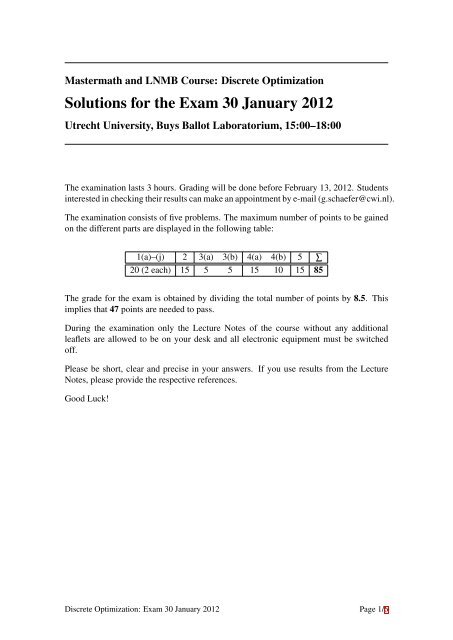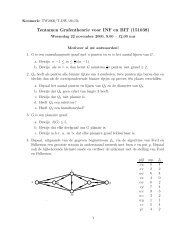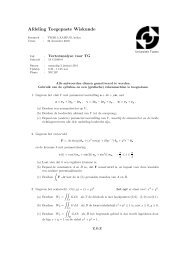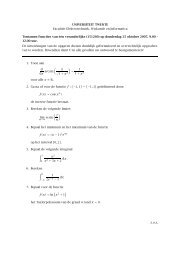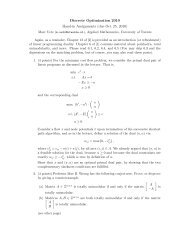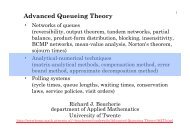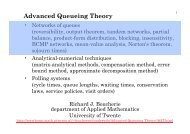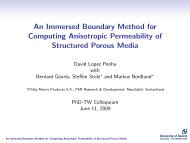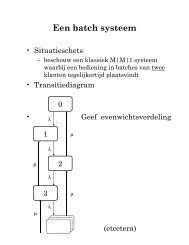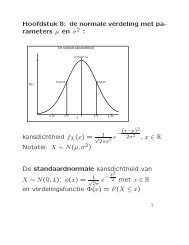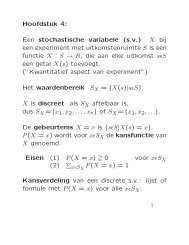Create successful ePaper yourself
Turn your PDF publications into a flip-book with our unique Google optimized e-Paper software.
Mastermath and LNMB Course: Discrete Optimization<strong>Solutions</strong> <strong>for</strong> <strong>the</strong> <strong>Exam</strong> <strong>30</strong> <strong>January</strong> <strong>2012</strong>Utrecht University, Buys Ballot Laboratorium, 15:00–18:00The examination lasts 3 hours. Grading will be done be<strong>for</strong>e February 13, <strong>2012</strong>. Studentsinterested in checking <strong>the</strong>ir results can make an appointment by e-mail (g.schaefer@cwi.nl).The examination consists of five problems. The maximum number of points to be gainedon <strong>the</strong> different parts are displayed in <strong>the</strong> following table:1(a)–(j) 2 3(a) 3(b) 4(a) 4(b) 5 ∑20 (2 each) 15 5 5 15 10 15 85The grade <strong>for</strong> <strong>the</strong> exam is obtained by dividing <strong>the</strong> total number of points by 8.5. Thisimplies that 47 points are needed to pass.During <strong>the</strong> examination only <strong>the</strong> Lecture Notes of <strong>the</strong> course without any additionalleaflets are allowed to be on your desk and all electronic equipment must be switchedoff.Please be short, clear and precise in your answers. If you use results from <strong>the</strong> LectureNotes, please provide <strong>the</strong> respective references.Good Luck!Discrete Optimization: <strong>Exam</strong> <strong>30</strong> <strong>January</strong> <strong>2012</strong> Page 1/6
Problem 1 (20 points (2 points each)). State <strong>for</strong> each of <strong>the</strong> claims below whe<strong>the</strong>r it istrue of false. Note: You need not justify or prove your answers here.(a) 17nlogn = Θ(n 2 ).(b) Given a spanning tree T of a graph, <strong>the</strong> number of vertices that have odd degree in Tis even.(c) The symmetric difference M 1 △M 2 of two arbitrary matchings M 1 and M 2 exclusivelyconsists of even length cycles and isolated nodes.(d) If all capacities in <strong>the</strong> max-flow problem are integers, <strong>the</strong>n <strong>the</strong>re exists a maximumflow that is integral.(e) Let T be a minimum spanning tree of a graph G = (V,E) with edge cost c : E → R.By removing an edge e ∈ T from T , we obtain two trees whose node sets induce a cut(X, ¯X). Every edge e ′ that crosses (X, ¯X) satisfies c(e ′ ) ≥ c(e).(f) A pseudoflow that satisfies all capacity constraints is a flow.(g) If Π 1 ∈ NP and <strong>for</strong> every problem Π 2 ∈ NP, Π 1 ≼ Π 2 , <strong>the</strong>n Π 1 is NP-complete.(h) If Π 1 ∈ NP and Π 2 ≼ Π 1 <strong>for</strong> some NP-complete problem Π 2 , <strong>the</strong>n Π 1 is NP-complete.(i) The TSP problem in which all edge distances are ei<strong>the</strong>r 1 or 2 is NP-complete.(j) Suppose ALG is an α-approximation algorithm <strong>for</strong> an optimization problem Π whoseapproximation ratio is tight. Then <strong>for</strong> every ε > 0 <strong>the</strong>re is no (α − ε)-approximationalgorithm <strong>for</strong> Π (unless P = NP).Solution:(a) false(b) true(c) false(d) true(e) true(f) false(g) false(h) true(i) true(j) falseDiscrete Optimization: <strong>Exam</strong> <strong>30</strong> <strong>January</strong> <strong>2012</strong> Page 2/6
Problem 2 (15 points). Consider <strong>the</strong> maximum weight indegree-bounded subgraph problem:We are given a directed graph G = (V,E) with edge weights w : E → R + and degreebounds b : V → N. The goal is to determine a subset E ′ ⊆ E of maximum total weightw(E ′ ) = ∑ e∈E ′ w(e) such that every node u ∈ V has indegree at most b(u).Prove that <strong>the</strong> greedy algorithm <strong>for</strong> matroids solves this problem.Solution: DefineI = {E ′ ⊆ E | ∀v ∈ V, <strong>the</strong> indegree of v in <strong>the</strong> graph (V,E ′ ) is at most b(v)}.Clearly, I contains all indegree-bounded subgraphs of G with respect to b.We prove that <strong>the</strong> pair (E,I) is a matroid. By applying Theorem 3.1 of <strong>the</strong> Lecture Notesto (E,I) and w, we can <strong>the</strong>n conclude that <strong>the</strong> greedy algorithm <strong>for</strong> matroids solves <strong>the</strong>maximum weight indegree-bounded subgraph problem.We verify <strong>the</strong>reto that (E,I) satisfies all properties that define a matroid.◦ E is finite by definition.◦ (V, /0) is obviously an indegree-bounded subgraph with respect to b.◦ Let I ∈ I and let J ⊂ I. Then (V,I) is an indegree-bounded subgraph with respectto b. Because J is a subset of I, <strong>for</strong> all nodes v ∈ V it holds that <strong>the</strong> indegree ofv in (V,J) is at most <strong>the</strong> indegree of v in (V,I). So (V,J) is an indegree-boundedsubgraph with respect to b, and thus J ∈ I.◦ Let I,J ∈ I, |J| < |I|. Then (V,I) and (V,J) are both indegree-bounded subgraphswith respect to b. Note that <strong>the</strong> sum of <strong>the</strong> indegrees of <strong>the</strong> vertices in a directedgraph equals <strong>the</strong> number of edges in that graph. There<strong>for</strong>e <strong>the</strong>re is a vertex v whoseindegree in (V,I) is greater than its indegree in (V,J). So <strong>the</strong>re must be an edge(u,v) ∈ I\J <strong>for</strong> some u ∈ V . Adding this edge to J only increments <strong>the</strong> indegree ofv, but still <strong>the</strong> indegree of v in (V,J ∪ {(u,v)}) is at most <strong>the</strong> indegree of v in (V,I),which is at most b(v). So (V,J ∪ {(u,v)}) is an indegree-bounded subgraph withrespect to b, hence J ∪ {(u,v)} ∈ I.Problem 3 (5 + 5 points). The Hitchcock problem is as follows: We are given a set ofm sources M = {1,...,m} and a set of n terminals N = {1,...,n}. Every source i ∈ Mhas a supply of s(i) ∈ N units and every terminal j ∈ N has a demand of d( j) ∈ N units.We assume that ∑ i∈M s(i) = ∑ j∈N d( j). The cost to send one unit from source i ∈ M toterminal j ∈ N is given by c(i, j) ∈ R + . An allocation specifies <strong>for</strong> each pair (i, j) ∈ M ×N<strong>the</strong> amount x(i, j) that is sent from i to j. An allocation is feasible if it satisfies <strong>the</strong> supplyof every source i ∈ M and <strong>the</strong> demand of every terminal j ∈ N. The goal is to compute afeasible allocation x of minimum total cost ∑ (i, j)∈M×N c(i, j)x(i, j).(a) Formulate <strong>the</strong> Hitchcock problem as an integer linear program and derive <strong>the</strong> respectiveLP relaxation.Discrete Optimization: <strong>Exam</strong> <strong>30</strong> <strong>January</strong> <strong>2012</strong> Page 3/6
(b) Show that <strong>the</strong> set of feasible solutions of this LP is an integral polytope.Solution:(a) An integer linear programming <strong>for</strong>mulation <strong>for</strong> this problem isminimizesubject toThe LP relaxation isminimizesubject to∑ c(i, j)x(i, j)(i, j)∈M×N∑ x(i, j) ≤ s(i)j∈Nx(i, j) ≥ d( j)∑i∈Mx(i, j) ∈ N∑ c(i, j)x(i, j)(i, j)∈M×N∑ x(i, j) ≤ s(i)j∈Nx(i, j) ≥ d( j)∑i∈Mx(i, j) ≥ 0(b) The linear programming relaxation (3) is equivalent tominimizesubject to∑ c(i, j)x(i, j)(i, j)∈M×N∑ x(i, j) ≤ s(i)j∈N− ∑ x(i, j) ≤ −d( j)i∈Mx(i, j) ≥ 0∀i ∈ M∀ j ∈ N∀(i, j) ∈ M × N∀i ∈ M∀ j ∈ N∀(i, j) ∈ M × N∀i ∈ M∀ j ∈ N∀(i, j) ∈ M × NObserve that this linear programming <strong>for</strong>mulation is of <strong>the</strong> <strong>for</strong>m stated in Theorem8.8 of <strong>the</strong> Lecture Notes. Also note that <strong>the</strong> coefficient matrix of this linear programis <strong>the</strong> incident matrix of a directed graph (which is even complete bipartite). Soby Corollary 8.1 of <strong>the</strong> Lecture Notes, <strong>the</strong> coefficient matrix is totally unimodular.There<strong>for</strong>e, by Theorem 8.8 of <strong>the</strong> Lecture Notes, <strong>the</strong> polytope of feasible solutions of<strong>the</strong> linear program is integral.(1)(2)(3)Problem 4 (15 + 10 points). In <strong>the</strong> longest s,t-path problem we are given a directedgraph G = (V,E) with edge weights w : E → R + , a source node s ∈ V and a target nodet ∈ V . The goal is to compute a simple s,t-path P of maximum total weight w(P) =∑ e∈P w(e).(a) The decision variant of <strong>the</strong> problem is to determine whe<strong>the</strong>r <strong>the</strong>re exists a simple s,tpathof total weight at least K, where K is a given parameter. Show that this problem isNP-complete. (Hint: Use that <strong>the</strong> Hamiltonian path problem is NP-complete: Givenan undirected graph G, determine whe<strong>the</strong>r G contains a Hamiltonian path.)Discrete Optimization: <strong>Exam</strong> <strong>30</strong> <strong>January</strong> <strong>2012</strong> Page 4/6
(b) Show that <strong>the</strong> longest s,t-path problem in acyclic graphs can be solved in time O(n +m), where n and m refer to <strong>the</strong> number of nodes and edges of G, respectively.Solution:(a) It is clear that <strong>the</strong> decision problem is in NP: A certificate <strong>for</strong> an instance of <strong>the</strong>problem is a subset of <strong>the</strong> edges that <strong>for</strong>ms an s,t-path of a total weight that exceedsK. Checking whe<strong>the</strong>r <strong>the</strong> total weight of <strong>the</strong> set of edges exceeds K is obviouslypossible in polynomial time. Checking whe<strong>the</strong>r a set of edges <strong>for</strong>ms a path can bedone by verifying whe<strong>the</strong>r s and t occur in exactly one of <strong>the</strong> edges of <strong>the</strong> edge set,and checking whe<strong>the</strong>r all remaining vertices of <strong>the</strong> graph occur ei<strong>the</strong>r in 0 or 2 of <strong>the</strong>edges of <strong>the</strong> edge set. It is clear that this is a straight<strong>for</strong>ward procedure that can beexecuted in polynomial time.We next show that <strong>the</strong> Hamiltonian path problem is polynomial-time reducible to <strong>the</strong>longest s,t-path problem. It <strong>the</strong>n follows that <strong>the</strong> longest s,t-path problem is NPcomplete.The reduction works as follows: Let G = (V,E) be an instance of <strong>the</strong>Hamiltonian path problem. Construct from G <strong>the</strong> instance I = (G ′ = (V ′ ,E ′ ),w :E ′ → R + ,K,s,t). In this instance, s and t are vertices in V ′ \V , V ′ = V ∪ {s,t}, andE ′ = {(u,v),(v,u) | (u,v) ∈ E} ∪ {(s,u),(u,t) : u ∈ V }. Moreover w is <strong>the</strong> functionthat maps all edges to 1, except those connected to s or t, which are mapped to 0.Lastly, K is set to |V | − 1.Obviously, this reduction takes polynomial time: Constructing K is a matter of counting<strong>the</strong> number of vertices in V , taking O(n) time. Specifying s and t and constructingV ′ from V takes O(1) time. Constructing E ′ requires replacing each edge in E bytwo directed edges, and adding two additional edges to each vertex, so this step takesO(m + n) time.We prove that G is a yes-instance of <strong>the</strong> Hamiltonian path problem if and only if I isa yes-instance of <strong>the</strong> longest s,t-path problem.(⇐) Let ((v 1 ,v 2 ),(v 2 ,v 3 ),...,(v n−1 ,v n )) be a Hamiltonian path <strong>for</strong> G. Then <strong>the</strong>simple path ((s,v 1 ),(v 1 ,v 2 ),(v 2 ,v 3 ),...,(v n−1 ,v n ),(v n ,t)) contains |V | − 1 edges ofweight 1, and 2 edges of weight 0, by construction. So it is a simple s,t-path of weight|V | − 1 <strong>for</strong> G ′ . So I is a yes-instance of <strong>the</strong> longest path problem.(⇒) Suppose that <strong>the</strong> path ((s,v 1 ),(v 1 ,v 2 ),(v 2 ,v 3 ),...,(v k−1 ,v k ),(v k ,t)) (<strong>for</strong> somek) is a simple path of weight |V | − 1. The edges (s,v 1 ) and (v k ,t) have weight0, so <strong>the</strong> path (v 1 ,v 2 ),(v 2 ,v 3 ),...,(v k−1 ,v k ) must have weight |V | − 1. Becauseall edges not connected to s or t have weight 1, it must be that k = n. Because(v 1 ,v 2 ),(v 2 ,v 3 ),...,(v k−1 ,v k ) is a simple directed path of n − 1 edges in G ′ , by constructionit is a simple undirected path of n − 1 edges in G. In o<strong>the</strong>r words, it is aHamiltonian path in G, so G is a yes-instance of <strong>the</strong> Hamiltonian path problem.(b) Define a cost function c : E → R as c = −w and consider <strong>the</strong> graph G with costfunction c. Note that (G,c) does not contain any negative cycles because G is acyclic.Now, P is a longest s,t-path in (G,w) iff P is a shortest s,t-path in (G,c). We thusneed to compute a shortest s,t-path in (G,c). This can be done in time O(n + m)using <strong>the</strong> algorithm of Assignment 2 (Problem 1).Discrete Optimization: <strong>Exam</strong> <strong>30</strong> <strong>January</strong> <strong>2012</strong> Page 5/6
Problem 5 (15 points). Consider <strong>the</strong> maximum weight acyclic subgraph problem: Weare given a directed graph G = (V,E) with edge weights w : E → R + . The goal is todetermine a subset E ′ ⊆ E of maximum total weight w(E ′ ) = ∑ e∈E ′ w(e) such that <strong>the</strong>subgraph G ′ = (V,E ′ ) induced by E ′ is acyclic.Derive a 2-approximation algorithm <strong>for</strong> this problem and show that its approximationratio is tight. (Hint: Assign a unique number r(u) to every node u ∈ V of G. An edge(u,v) ∈ E is a <strong>for</strong>ward edge if r(u) < r(v). Prove that <strong>the</strong> set of all <strong>for</strong>ward edges inducesan acyclic subgraph of G.)Solution: The algorithm is as follows:Input: A directed graph G = (V,E) with edge weights w : E → R + .Output: A subset E ′ ⊆ E such that G ′ = (V,E ′ ) is acyclic.1 Fix an arbitrary order u 1 ,...,u n on <strong>the</strong> nodes of G and define r(u i ) = i.2 Call an edge (u,v) ∈ E a <strong>for</strong>ward edge if r(u) < r(v) and a backward edgeo<strong>the</strong>rwise. Let F and B be <strong>the</strong> set of all <strong>for</strong>ward and backward edges, respectively.3 Let E ′ = F if w(F) > w(B) and E ′ = B o<strong>the</strong>rwise.4 return E’We prove that <strong>the</strong> above algorithm is a 2-approximation <strong>for</strong> <strong>the</strong> maximum weight acyclicsubgraph problem.1. The algorithm has polynomial running time: Defining r(u) <strong>for</strong> every node u ∈ Vtakes O(n) time and identifying all <strong>for</strong>ward and backward edges needs O(m) time.Altoge<strong>the</strong>r <strong>the</strong> algorithm thus needs O(n + m) time.2. The algorithm computes a feasible solution: Suppose <strong>for</strong> <strong>the</strong> sake of a contradictionthat <strong>the</strong> subgraph G = (V,E ′ ) contains a cycle C = (v 1 ,v 2 ,...,v k = v 1 ). Because Cconsists only of <strong>for</strong>ward (or backward) edges, we must have r(v 1 ) < r(v 2 ) < ··· r(v 2 ) > ··· > r(v k ) = r(v 1 )), which is a contradiction.3. The algorithm computes a 2-approximate solution: Note that F and B partition <strong>the</strong>edge set E, i.e., E = F ∪ B and F ∩ B = /0. Also note that OPT ≤ w(E). Because wechoose <strong>the</strong> set of larger weight among F and B, we haveThat is, w(E ′ ) ≥ 1 2 OPT.2w(E ′ ) ≥ w(F) + w(B) = w(E) ≥ OPT.The approximation ratio of is tight as <strong>the</strong> following example shows: Let V = {u 1 ,u 2 ,u 3 }and assume that this is <strong>the</strong> order fixed in Step 1 of <strong>the</strong> algorithm. Fur<strong>the</strong>r, let E ={(u 1 ,u 3 ),(u 3 ,u 2 )} and w(e) = 1 <strong>for</strong> both edges. Note that <strong>the</strong> entire graph is acyclic.Thus <strong>the</strong> edge set E is <strong>the</strong> optimal solution with weight OPT = w(E) = 2. The algorithm,however, will output <strong>the</strong> edge set E ′ = {(u 3 ,u 2 )} with weight w(E ′ ) = 1.Discrete Optimization: <strong>Exam</strong> <strong>30</strong> <strong>January</strong> <strong>2012</strong> Page 6/6


